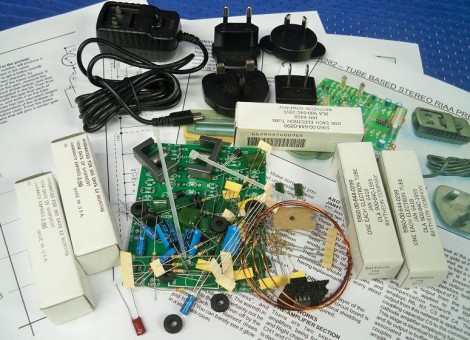
If you’re curious about tube amps but don’t have a firm enough knowledge base to dive right in you might want to try a kit. [Mark Houston] reviewed one such kit and we enjoyed reading about his experiences. It comes with everything you need save soldering tools, an enclosure, and the final connectors ([Mark] used RCA connectors). There is a full schematic available and the assembly instructions take you through tube matching and using that piece of copper coil you see in the picture to wind your own inductor. Consider trying this primer before you jump into building a single tube, multiple tube, or an amplifier of your own design.
[Thanks Gio]















I like tubes also, but why is this better than
a non-tube amp?
Looks like it has several negatives like mismatched tubes and sensitivity to vibrations,
so I’d like to know what makes is superior to a
simple transistor or IC amplifier.
-big facepalm-
Erm… Phono != headphones
Good luck hooking your headphones up to this preamp for turntables!
this particular tube amp may not be particularly better than a solid state amp, as it’s geared more toward getting familiar with building tube amps rather than being properly designed for sound quality. However, a tube amp with a similar level of engineering to a comparable solid state amp will have different characteristics within its power range, and will handle clipping better than a solid state amp. There’s pros and cons to both technologies.
@Alan
Some people prefer the kind of distortion caused by tube amps over the kind of distortion caused by solid state.
Having worked at an audio company, I’ve learned not to get between two engineers of opposing preferences.
OK, so since I listen to music within
the non-distorting range of my amps
there’s no advantage to a tube amp
other than its prettiness (which I love).
And lots of disadvantages it looks like:
– Heat during operation.
– Hard-to-match component variability.
– Sensitivity to vibration.
– Higher power consumption.
– Fragility.
The best I understand it, the biggest difference between solidstate and tube amps (besides the distortion levels), is that the solidstate amps produce even harmonics in the waveforms and the tubes create odd numbered harmonics. This is supposed to create a different “tone”. I guess I’ve lost enough hearing sensitivity, and never got to listen to tubes much, so I can’t tell.
Maybe I’m just a weird guy, but the idea of connecting a self made device that internally uses very high voltages to another electric device mounted on my head (and specially placed on my sensitive and invaluable ears) scares me a lot.
@ Roel:
How many people using headphones in the good old days died that way?
“The external power supply is a small 5V switch-mode power supply”
Funny combination with tube amp. I always tought that a person who wants a tube amp would also like a PSU with regular transformer and 60 000uF capasitance on ripple rejection.
is that a transistor i see? :o
@rallen: Tubes produce even and odd harmonics, solid state devices suppress even harmonics.
Unless you’re overdriving your amplifier (to purposely get distortion) the response is almost identical to solid state into a resistive load. Since no one listens to their stereo if it’s loud enough to distort anyway, there is essentially no difference.
The difference is in the non-linear frequency response of the tube amp into an inductive load (speaker). This has the effect of boosting or cutting certain frequencies and acting like an EQ.
http://www.audioasylum.com/audio/faq/tubeprimer.html
Although I may never purchase and build one of these, I enjoyed reading Mark Houston’s review. If you are an audiophile, you have to read the blind-test that Mark performed with this parts-bin preamp.
What’s the difference between solid-state and tube amps? It could be caused by the harmonic element, or the non-linear response of the tubes, and even some amps had interstage transformer coupling but the bottom line is the sound – some say that the tube amps are just plain “warmer sounding”.
Warm is not a sound, it’s a temperature.
No wonder I don’t understand audiopiles.
its like having your ears stabbed with a nerf dart, vs a real dart
it is much warmer, one listen to a (decent not a kit toy) tube amp and you can tell what they are saying
@Alan why don’t you also get after those art people who try and say there are warm and cool colors, or food, wine and beer connoisseurs who say that there are different weights to flavors
@junkhacker, that statement was cracked me up. @Alan: read about synethesia. It’s when certain types of different senses evoke the visualization of certain colors. Are you an emotionless blob of gray or somethin’?
Wint. That’s a completely different thing than Amplifiers man.
I had a nice little Oakey Chardonnay last
night that was quite full of itself. It had
a big head and an arrogant finish. Quite enjoyable.
And it only had odd harmonics so that’s
also a good thing.
Oh, I ran it past a magnet to add Oxygen
to the warmth carriers. You’ve got to do that.
I agree with elal1862. this is NOT a headphone amp.
{facepalm}
Guys, this isn’t a HEADPHONE amp, it’s a Stereo RIAA-equalised *PREAMP* for use with a turntable and magnetic pickup, generically known as “phono” as in “phonograph”, ahead of any amplifier.
Maybe I should try this out. It would probbably be better than that shitty integrated solid state amp my turntable has. (if fact, anything would)
Be warned, this kit is crap! The tubes used are highly microphonic which gives you both a high pitch feedback and a plopping sound. No wonder it’s so cheap.
Apart from that, it’d be a wonder if you get all the parts needed and the right documentation from oatley..
i have the k279 tube buffer kit with the same tubes….i was tapping them with a screwdriver to get them to ring….no ringing for me!